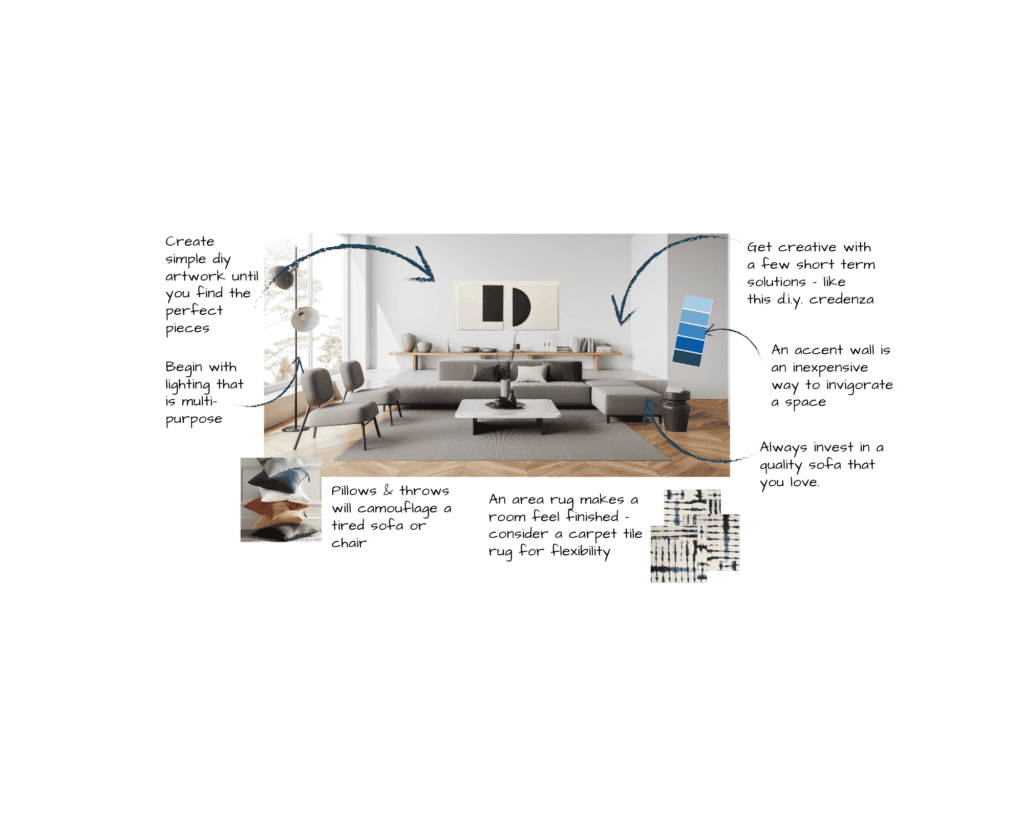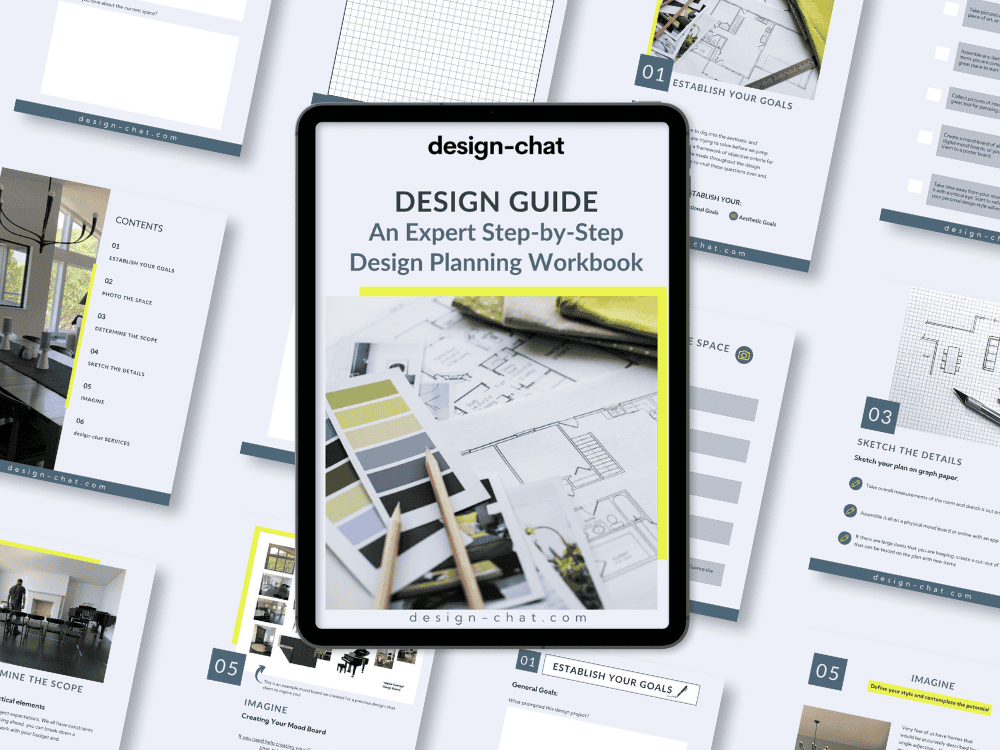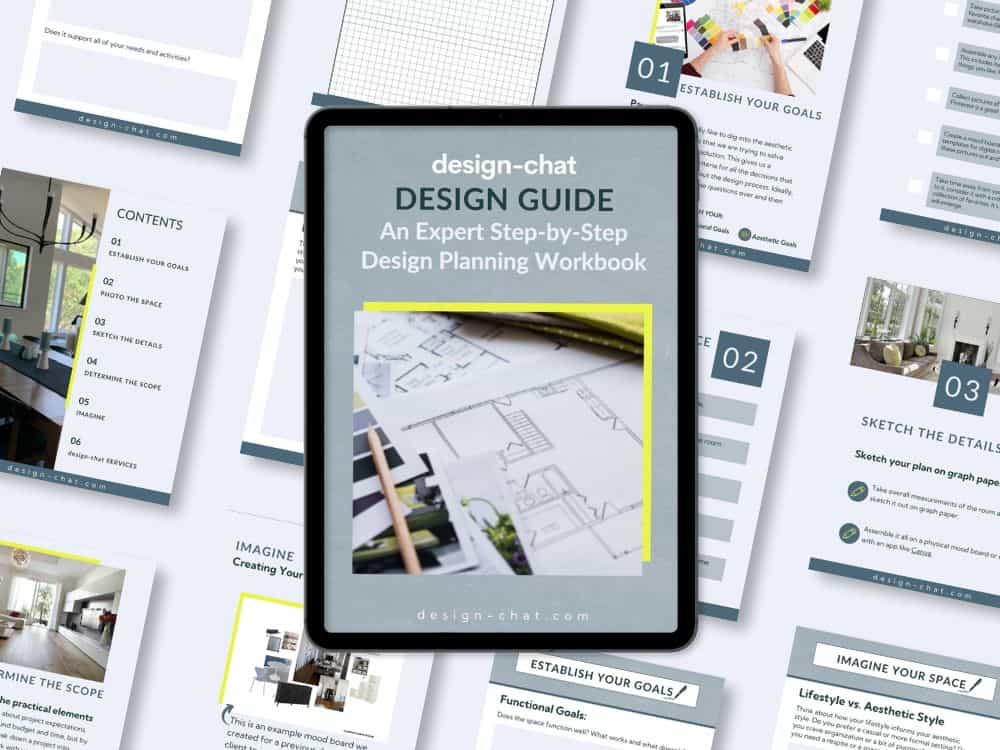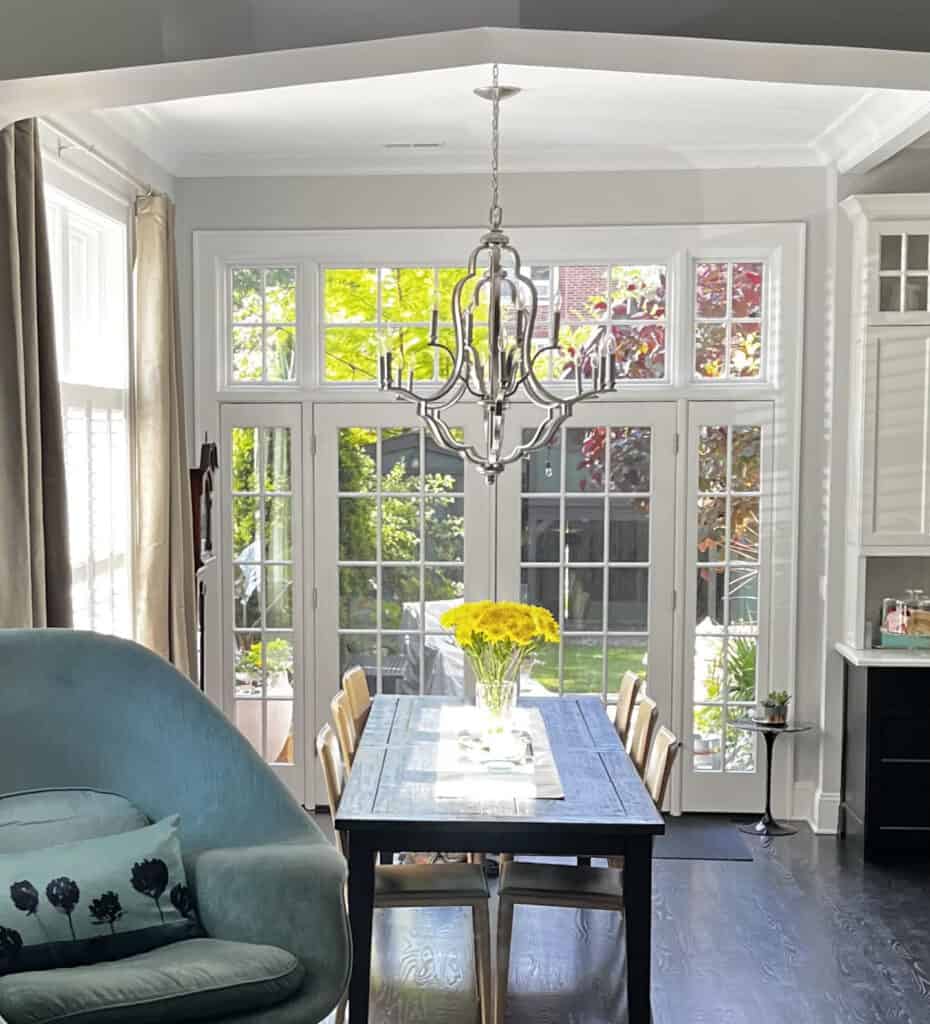The Benefits of Decorating a Home on a Budget
Whether you are just starting a new project, overwhelmed by an ongoing design, or have a space that needs a refresh, it’s always helpful to begin by considering the budget. The good news is that designing with costs in mind requires you to get more creative with your solutions and gives you a framework for decision-making.
Plan & Prioritize Your Home Decor Ideas
Embracing the high-low approach to design can be a game-changer. It’s about knowing when to invest in quality, mixing savvy bargains with clever design tricks, and leaving a bit for the occasional splurge. This approach stretches your budget, fosters resourcefulness, and sparks creativity. The key is to start with a well-developed plan, decide how much you want to invest in each item, and not sacrifice quality.
Great Way to Add Creative Expression and Personal Style
The best bit is that if you’re focused on creative problem-solving, diligent in finding solutions that meet your budget goals, and clever about balancing your design’s low and high elements, you’ll end up with a sophisticated design that celebrates your unique personal style. No one will know that you did it for less unless you decide to brag about your savvy design sense!
Make a Huge Difference While Staying on Budget
Start every design project (big or small) by clearly defining your design goals. This means planning how you want your space to look and feel and how it functions and developing detailed budget goals for all design elements. Having a clear vision and budget in mind from the start can be a great motivator when starting a new design project.
Get our free Design Guide HERE for guidance on starting your project.
Decorate on a Budget by Keeping it Simple
If you have a new home and lack the funds to outfit the entire space immediately, consider embracing a deliberately “minimalistic” look. Start by creating a clean shell and purchasing the most essential functional pieces, and then add layers as the budget allows. Your house will feel more harmonious if you add items slowly rather than finishing one room at a time.
Resourcefulness & Satisfaction – 39 of Our Favorite Tips, Tricks and Hacks
Discovering creative and cost-effective ways to overcome design challenges is immensely satisfying. We adore the thrill of finding a bargain, and it’s this very process that allows for the occasional splurge. Below, we share some of our most cherished cost-effective design tricks, hacks, and budget-friendly sources for every home decor category.
Paint: A budget-friendly way to make a big impact
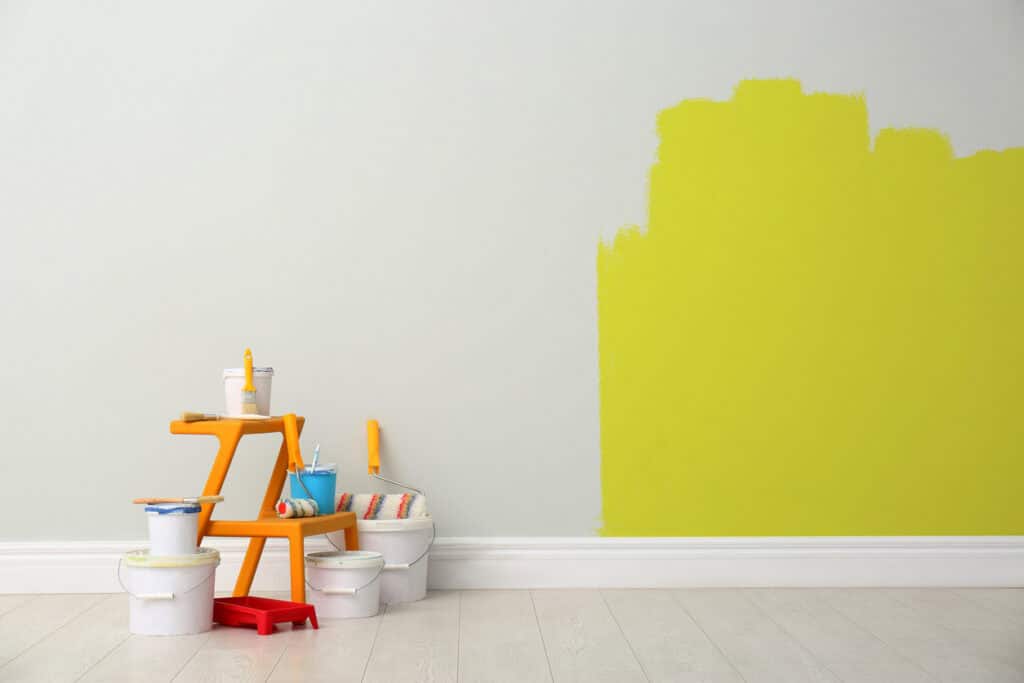
Paint is a budget-friendly way to make a significant impact.
This is especially true if you are okay with picking up the brush yourself! Make sure you research the best way to prepare the surface for painting and invest in high-quality paint (this is not a place to skimp).
- Adding a single-painted accent wall is a quick and inexpensive way to set a new tone and add energy to a room.
- Subtle shifts in the color of doors, trim, and baseboards can add sophistication to a room that feels flat with minimal expense.
- Wallcovering is another way to energize your space, and the new peel-and-stick options are a cost-effective DIY solution.
✏️ Design Tip:
Are you planning to implement your design slowly? We suggest establishing the palette for your space at the beginning of your project and painting the space as the initial step. This is a great way to freshen up the vibe and set the tone for future changes.
Flooring: Our tricks to keep costs down
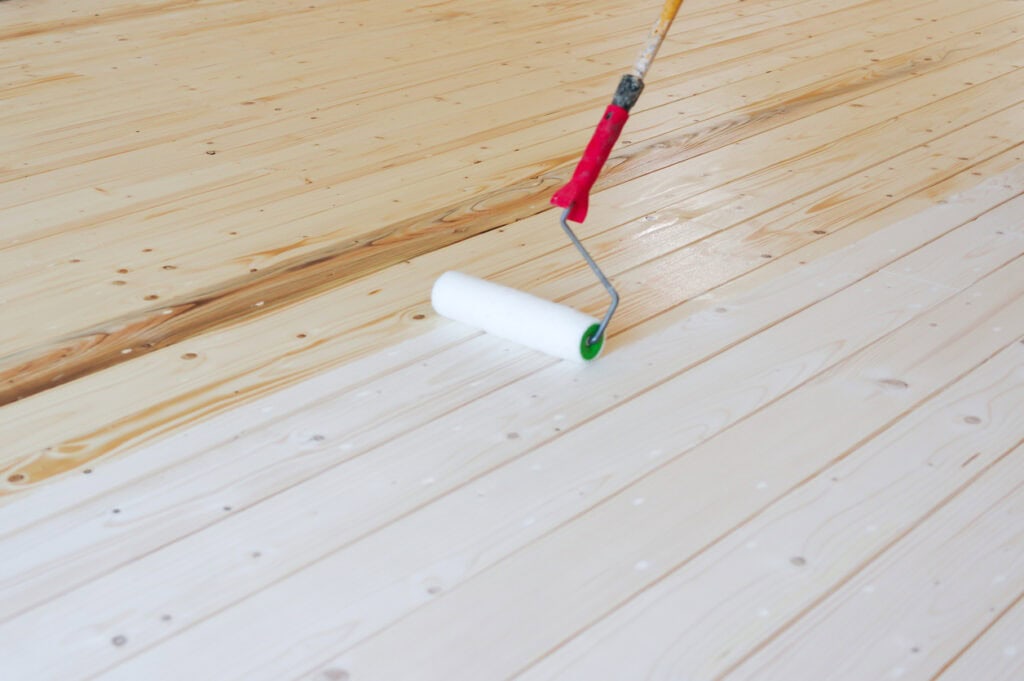
Flooring is expensive, but we have a few tricks to keep costs down.
Replacing flooring is costly, so it’s always good to start by making the most of what you have when you’re on a tight budget.
- Old wood floors can take on a pinkish or yellowed color that dates a whole space, but updating with a light, dark, or even a colored stain can change and invigorate the overall feel of your space.
- Paint is another way to salvage wood floors and camouflage tile floors. Painted floor surfaces are more fragile, and we don’t recommend them for wet areas. We always integrate an area rug or runner in these spaces to offset the inevitable flaws in the finish and protect the high-traffic zones.
- If you’re stuck with a wall-to-wall carpet that doesn’t work well with your design, consider the common British trick of adding an area rug over the top of the carpet. Although we don’t love this for a long-term solution, it’s a tolerable stop-gap trick until you can afford to upgrade your flooring.
That brings us to the challenging category of area rugs, which can be shockingly expensive! Area rugs define space, create focal points, and add a sophisticated and finished atmosphere. A large rug encompassing most of the furniture will feel most elegant. These are a few of our favorite ways to keep rug costs down.
- Floor Carpet Tile has a great selection of patterned and textural carpets in 20″ x 20″ tiles. We love this solution because you can easily create a rug for an unusual-sized space, and the tile can be reconfigured for different areas of your home as needs change.
- Rug bargains can be found online, but assessing color and quality can be challenging. Ensure you check the return policy and costs and are prepared to return a rug if it doesn’t meet expectations. Note: You must ship it back in the same package, so open the role strategically.
- Facebook marketplace and consignment stores are good sources for used rugs, but you’ll need to be discerning and remember to factor in cleaning costs.
- Kaiyo has pre-loved area rug options that have been assessed and cleaned.
✏️ Design Tip:
If you require an odd-sized area rug, consider buying a larger one and having it cut down and bound locally. Finding a fabricator willing to do this project can be challenging but worthwhile, as it can be significantly less expensive than the custom-sized option.
Furniture: Find cost-effective solutions by expanding your search or consider a furniture makeover
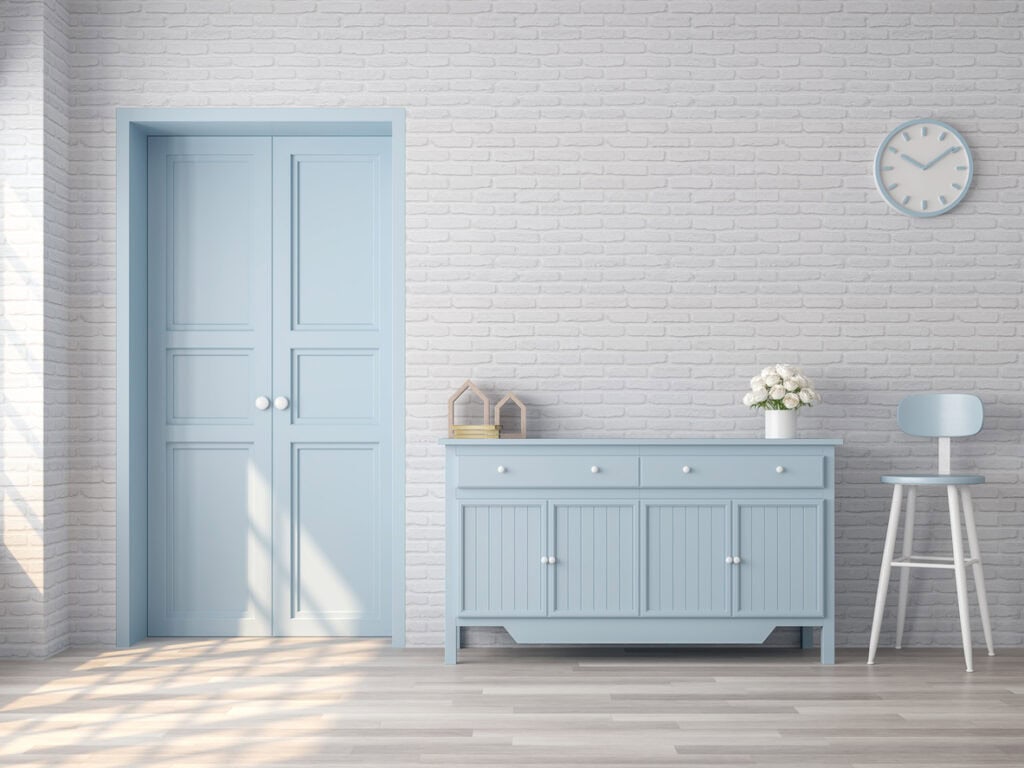
Expand your search for cost-effective furniture solutions.
To stretch your furniture budget, we suggest a high-low design solution that mixes chic thrifting and pre-loved finds with thoughtful investment pieces and the occasional splurge. The first step is always shopping your home to see what can be repurposed or reinvigorated with a coat of paint or new upholstery.
- Start by boosting your budget by selling the pieces that won’t work in the new design.
- Vintage and antique wood pieces are often of higher quality than new items—armoires, chests of drawers, tables, and headboards can be easily updated with a new finish and hardware.
- Keep a list of the items you are looking for in the pre-loved category, regularly peruse your favorite local and online sources, and set up alerts for new listings.
- Facebook Marketplace makes buying and selling pre-loved items easy.
- Local online auctions and estate sales are another fun source for used items.
- Kaiyo buys and sells used furniture with a focus on great design.
- Check out your local thrift and consignment stores.
- Regularly visit antique and flea markets, and don’t hesitate to check in with your favorite vendors to let them know what you’re looking for, as they may have access to a broader inventory.
- The secret to high-low design is knowing when to invest; we always prioritize high-quality, well-designed sofas and lounge chairs. Doing an in-person “sit test” is essential, so we suggest starting with local retailers in your area.
- Watch for sales with your favorite furniture brands – it can make a huge difference.
- Home Goods often has new sofas and chairs from manufacturers known for quality.
- Most name-brand furniture retailers have outlet stores; check to see what’s near you.
- Ikea, Wayfair, Target, and Amazon are good sources for simple, non-upholstered items.
✏️ Design Tip:
Reupholstering can be expensive, but prices vary. Do your research and get to know a local upholster you can trust to provide reasonable estimates and guidance on appropriate fabric choices.
Drapery: Curtains and blinds on a budget
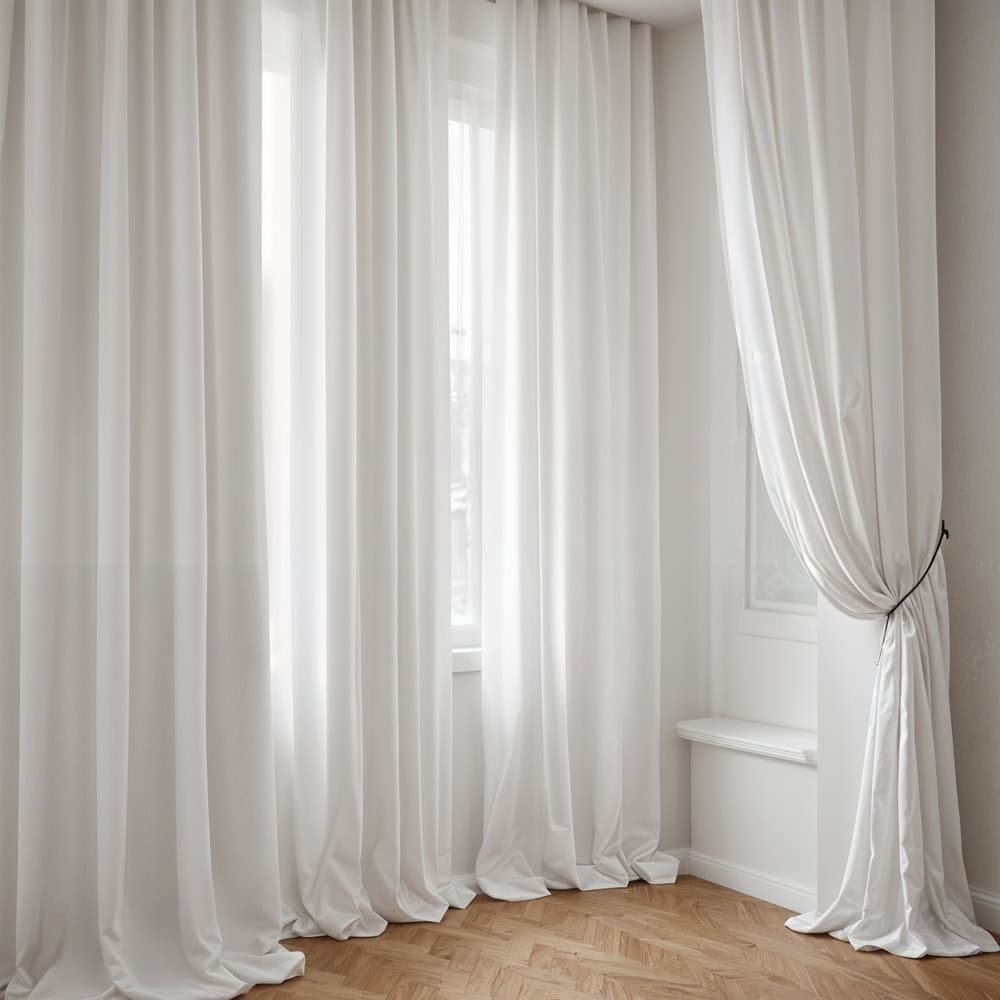
Drapery can add a layer of elegance and function to every room, but custom solutions are expensive. Below are the hacks we use to stay on budget.
- Natural fibers like cotton and silk look more sophisticated than synthetic fibers, so stay focused while searching for a bargain.
- It’s less expensive to buy a standard-length panel and shorten it than to buy a custom size. Remember that drapery panels that touch the floor or puddle look the most sophisticated.
- Restoration Hardware has beautiful drapes, but Pottery Barn and West Elm have similar high-quality items for significantly less. Many online retailers have good options and also offer fabric samples. Always watch for sales and check the outlet stores.
- eBay and Facebook Marketplace are surprisingly good sources for pre-loved drapery but remember to factor in cleaning costs.
- If you find the perfect bargain drape but it doesn’t have the lining you need, remember that you can buy a light-filtering or black-out panel from sources like Amazon and layer your drape over it.
- Blinds are trickier, but bargains can be found in standard sizes. One of our favorites is the very simple Ringblomma Roman Blind from Ikea – it has a linen look and a clever magnetic strip for adjusting the height.
✏️ Design Tip:
Hardware can be pricey, but this is an area where you can cut corners. As long as the rod is solid enough to hold the weight of your drape, it’s okay to spend less, as it’s an item that is typically never seen up close. Keep the style simple, and remember that drapery rings are relatively inexpensive and look much more sophisticated than rod pockets or tabtops.
Storage: Clever solutions for small and large spaces
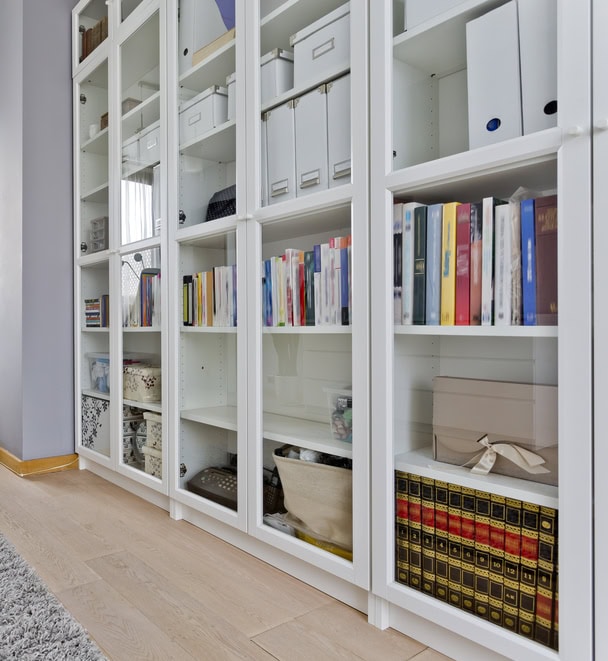
It’s easy to swing by the Container Store and solve all your storage problems, but we prefer more unexpected and creative solutions. Get clever about repurposing a pre-loved item or transforming simple new pieces.
- Armoires are lovely ways to house media equipment or can be fitted to transform it into workstations. Often overlooked, they offer great deals.
- In a smaller space, a chest of drawers can double as a credenza in a foyer, a living room side table, or a nightstand. As mentioned, you can find high-quality pieces in this category that are easily transformed with paint and new hardware.
- Built-in storage adds an elegant touch, but it’s expensive. We love the numerous online hacks to make simple Ikea storage pieces appear integrated, and this approach can also work for other used items, like bookcases and credenzas.
✏️ Design Tip:
If you’re tight on space, be clever with storage and always try to find dual-function solutions, like benches that double as storage for bedding or shoes.
Art: Personalized, cost-effective art solutions or consider DIY
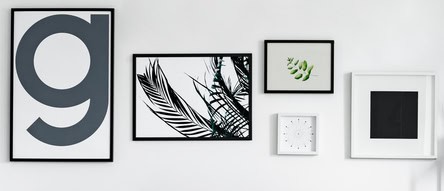
Adding artwork to a space is a great way to express your style, but finding pieces you love can take some time. We have some ideas for cost-effective art sources and some tricks for filling the space with placeholders while you slowly search for the perfect items.
- Artfinder is an excellent source for original artwork and a nice way to connect directly with artists. It also allows you to search by style, size, color, and cost.
- Flea markets and consignment stores are good sources for artwork and used frames.
- Print and frame your photographs—blowing up images and allowing them to become distorted or printing in black and white can be interesting. There are many online printing options, including printing on canvas.
- Frame unexpected items – think about your passions and create something original.
- DIY—If you need a large piece or series of pieces, consider buying pre-stretched canvasses and letting your kids have fun (hint: you choose the palette), or try it yourself. This can be another good way to fill space until you can find and afford the perfect items.
✏️ Design Tip:
Framing art is crazy expensive, but our favorite hack is to buy simple frames from Amazon or the local artist supply store and order custom-size mats from Matboard and More.
Accessories & Lighting: Accessorizing on a budget
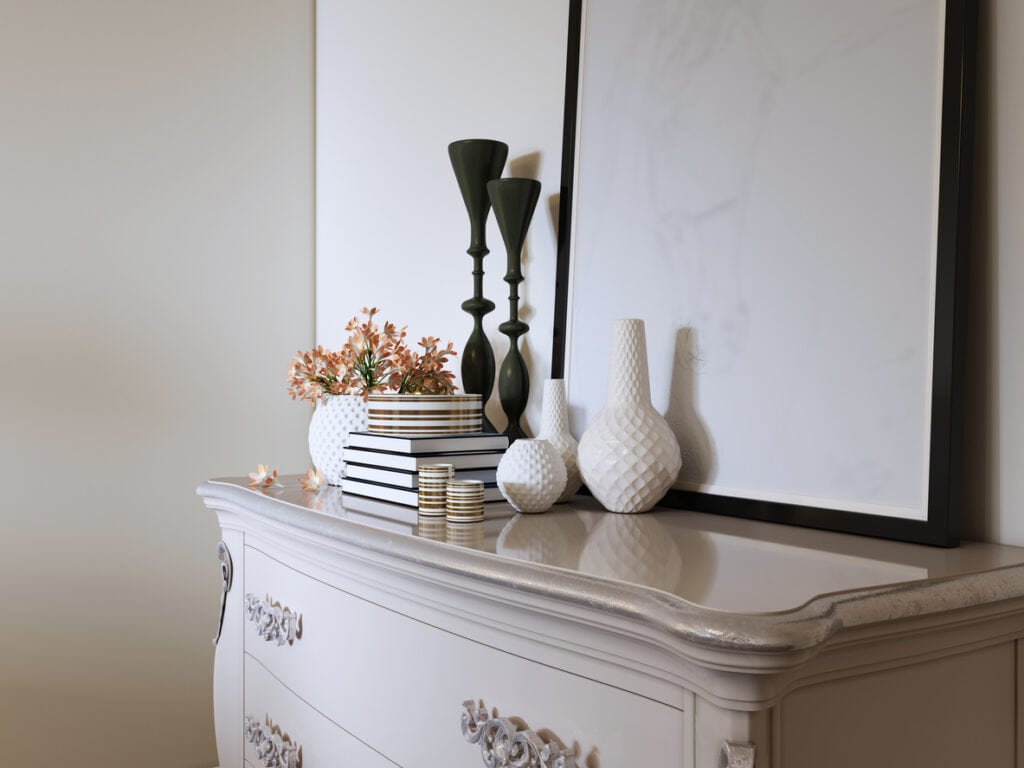
Accessorizing is a chance to personalize your space with objects you love and get creative. Have a plan, keep a list of what you’re searching for, and always be on the lookout.
- Pre-loved accessories are our favorite category, and when we are on the hunt, we regularly visit our favorite vintage shops, thrift stores, flea markets, and the occasional tag sale.
- Never underestimate the power of a decorative pillow or throw—they can distract from a threadbare sofa or a tired lounge chair you aren’t ready to replace. Home Goods, Amazon, and Wayfair are excellent sources for inexpensive pillows. Pottery Barn always has a great selection of solid-color pillow covers in velvet, linen, and cotton.
- A stack of books is an excellent addition to every room. Used bookstores are a good source, and you can also look for used book fairs in your community.
- Thrift stores are great for lamps. Remember that most surfaces, including glass, porcelain, and metal, can be painted, and there are countless sources for inexpensive shades online.
- If you’re short on lighting and plan to add items slowly, start with a multi-functional floor lamp that you can use for tasks and bounce light off the ceiling or walls.
✏️ Design Tip:
Down-filled throw pillows feel and look great; a cost-effective solution is to splurge on lovely pillow covers and order Ikea down pillow inserts to offset the costs.
Designing is not just a task; it’s a journey of creativity and self-expression.
Enjoy the process, experiment with different ideas, and let your imagination run wild. The joy of designing is in the journey, not just the destination.
Sometimes, a little extra guidance from an interior designer goes a long way.
Whether you’re updating a room or reimagining your entire home, our team is here to help you realize your vision. We’d love to collaborate with you to create the perfect design for your home.
Learn more about our virtual interior design solutions HERE.
